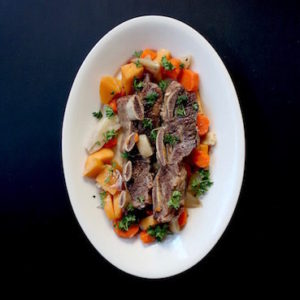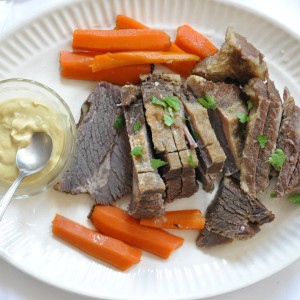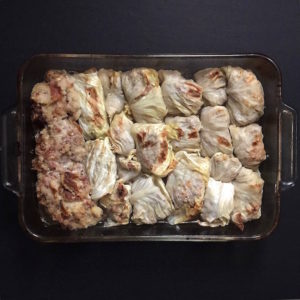Kitchen Note: repairing Pot Au Feu
Why not start with a nice NorCal flower picture?

I was trying to take flower pictures the other day, and this seems like a good excuse to use them.
Here’s another.

You may be wondering flowers have to with pot au feu, or boiled beef.
Nothing. They’re just pretty in an ugly world.

So, pot au feu. Why a kitchen note rather than a full post?

Because the recipe didn’t work perfectly, and I can’t, in good faith, post it and pretend.
Why put it up at all, then?
A few reasons. Most food blogs post the perfect stuff, with good reason. After all, who wants to cook a wonky recipe? But too often those perfect recipes are meant to represent the perfect lives lived by their producers. Me? I went shopping yesterday and locked the keys in the van.
More importantly, with a little thoughtful tweaking, we had a delicious meal on our plates. And if I could fix this meal–somebody who locks her keys in the car, somebody typing with a numb right hand courtesy of carpal tunnel–well, hey, you can fix a meal gone slightly wrong, too.
And what, exactly, did go wrong here?

Recipes for boiled beef, be they from Boston or Burgundy, invariably warn against cooking your beef in rapidly boiling water. The water is to barely simmer. Nay, it is to smile.
When John and I moved into this house in 2010, we took a major step down kitchenwise. We did, however, acquire a gas stove whose burners willingly smiled up at us.
And yet. Grigson or Waters, Rodgers or Wolfert: my boiled beef story reaches a single, unvarying conclusion. After four or five hours of cooking in smiling water, the beef resolutely refuses to cook. The vegetables, meanwhile, are mush. The oven is fired up, the pot tucked in. After an hour, perhaps two, the beef is meltingly tender.
And I am no wiser than before.

This pot au feu was no different. After four hours of gentlest poaching, the beef, an expensive, politically correct chuck roast, was a roof shingle. On went the oven. At 325F the broth was bubbling too vigorously; I turned it down to 300 degrees. Ninety minutes later, the pot was pulled out. Beef and cook chilled overnight.
The next morning I tasted uncertainly. The beef was wonderful, tender and perfectly seasoned.The vegetables were flavorful but overcooked. What to do?
Just thinking about putting the veg through the food mill made me tired. God knows people love their food mills. Not me. Food mills, they occupy a sub-basement in hell with dirty fine-mesh strainers while the “Happy” song plays on repeat.
Returning to our vegetables….I stared at them, placidly draining into cup full of braising liquid. WWNSD? (What would Nigel Slater do?)

Nigel Slater likes making fritters, pies, and parcels of vegetal items. He also makes mash in what the English call food mixers, aka Kitchenaids.
No way was I dealing with the Kitchenaid. Peeling two russets and boiling them in salty water was more up my street. Once soft, the potatoes got roughly mashed with their mushy friends rutabaga, turnip, and garlic. (Also carrot, pictured above.)

A quarter cup of heavy cream joined the team. Some of you are old enough to recall the Rolling Stones record Emotional Rescue (“I come to you on a fine Arab Charger….”). By the time you’re pushing fifty, you learn not to count on emotional rescue. Or any other kind, for that matter. Cream in mash you can count on. After all, you’re pouring it in yourself.

I often wonder if anyone reads this far down.
A little more about the veg…I’d added onion, garlic, rutabaga, turnip, and carrots to the boiled beef about an hour in. By the next morning, the onion was pretty much done for, so I discarded it.

In the The Art Of Simple Cooking, Alice Waters suggests adding marrow bones to the pot if not using bone-in cuts of beef. As my market sells marrow bones cheaply, I’d availed myself, but wouldn’t repeat it, as they mucked up the broth. Then again, somebody could’ve skimmed with more alacrity. Ahem.

At the end of all this I recalled Laurie Colwin’s “Boiled Beef”, from More Home Cooking. After much discussion of the ideal cut, Colwin instructs readers to cover their beef with either filtered water or springwater and tuck it into a 300F oven. Cook 3-5 hours. None of this stovetop business, Twenty-five years after Colwin’s death, all her books remain in print. One understands why.
Here, then is a recipe for boiled beef. It will work. It is not in my best interest to offer suspect recipes or otherwise lie to readers. I have enough problems, and in the next 48 hours promises to offer more.
My recipe is adapted and influenced from the usual suspects–Alice Waters, Judy Rodgers, Laurie Colwin, and Paula Wolfert. It is hardly original, authentic, or seriously French in any way. It is, however, tasty and filling food, hearty and warming. It will improve with time, meaning you could prepare this ahead if your plans include a weekend of civic activity in potentially foul weather.

“The hottest place in hell is reserved for those who remain neutral in times of great moral conflict.”
The Reverend Martin Luther King, Jr.
Where Do We Go From Here: Chaos Or Community?
Pot Au Feu (boiled beef)
Yield: approximately 4 servings, easily scaled upward
preparation time: 1-2 days if you presalt the meat, optional, 2-4 hours cooking time in the oven
One 2-3 pound chuck steak
2 pints unsalted chicken broth (optional, see note)
1 medium onion, peeled and halved
2 carrots, peeled and chunked
2 bay leaves
2-6 garlic cloves, left whole and unpeeled, to taste
1 sprig fresh thyme
a few peppercorns, lightly cracked
a few cloves (I go lightly here)
2-3 medium turnips, peeled and chunked
1 rutabaga, peeled and chunked (optional; this is a love or hate vegetable)
1 medium celery root, peeled and chunked (optional; like rutabaga, it’s love or hate)
salt and pepper
water to cover
at the table:
Dijon and/or Amora mustard
Cornichons
crusty bread
Presalting the meat: optional but flavor-boosting
1-2 days ahead, season the meat with about two teaspoons sea salt. I use Maldon, a large-crystal salt. If you are using a smaller crystal salt, like Diamond Kosher, use less, about 1 1/2 teaspoons. Salt both sides of the meat, cover it loosely, and refrigerate up to three days. Pre-salting does not dry the meat out; it gently seasons. You will use less, if any, salt at table. Judy Rodgers speaks eloquently about the practice; I direct you to The Zuni Cafe Cookbook.
The day you plan to cook, about one hour before cooking, bring meat to room temperature.
Blanch the meat:
Fill a large stockpot about halfway with cool water. Heat to just warm. Submerge the beef; add a teaspoon of salt (Rodgers advises this to avoid desalting meat). Bring water to low simmer for 2 minutes. Crud will rise to the surface along with lots of gray scum. Remove the meat and rinse well in cool water. Set aside.
Either rinse this stock pot or use a clean, heavy stockpot. While Rodgers advises a tall, narrow stockpot for making pot au feu, my stockpot is cheap, so I use a deep Staub 6-quart braiser.
Preheat oven to 300 degrees F.
Place the beef in your selected pot and set on medium heat. Add chicken broth, if using; the beef should rise above the surface by about an inch. Cover remainder with cold water to cover by about three inches, or use all cold water.
Add the onion, carrots, garlic, bay leaves, thyme, peppercorns, and cloves.
Add the remaining vegetables and bring pot to a simmer. Cover and place in oven 2-3 hours. Pot au feu is ready when beef is fork tender.
Pot au feu is traditionally served in courses, with the broth first and beef second; it is accompanied by cornichons,small dishes of sea salt, mustard vinaigrette.
Lacking a dishwasher, I serve everything at once, on a platter. Being too lazy to make vinaigrette, I plunk jars of mustard down on the table with spoons.
As noted above, the vegetables were overcooked when I made this. Discarding the spent onion, I mashed the remaining vegetables with two potatoes. Should you wish to go this route–not at all traditional–peel two large Russet potatoes and boil them in lightly salted water until soft. Drain the pot-au-feu vegetables and mash with potatoes. I added 1/4 cup heavy cream. Salt and pepper to taste.
Pot au feu will improve with time, but I wouldn’t keep it in the refrigerator more than five days. Leftover beef is wonderful in a sandwhich with horseradish. Leftover broth may be frozen up to three months. Use for soup or with pasta.
Notes: There are countless recipes for pot au feu, most calling for mixed bony cuts of beef and poultry. This recipe is radically–inauthentically–pared down. For excellent authentic recipes, see Elizabeth David’s French Provincial Cooking, Paula Wolfert’s Cooking Of Southwest France, Judy Rodgers’s Zuni Cafe Cookbook, and Alice Waters’s Art Of Simple Cooking (Volume I)
You can skip the chicken broth if you prefer and use all water.





